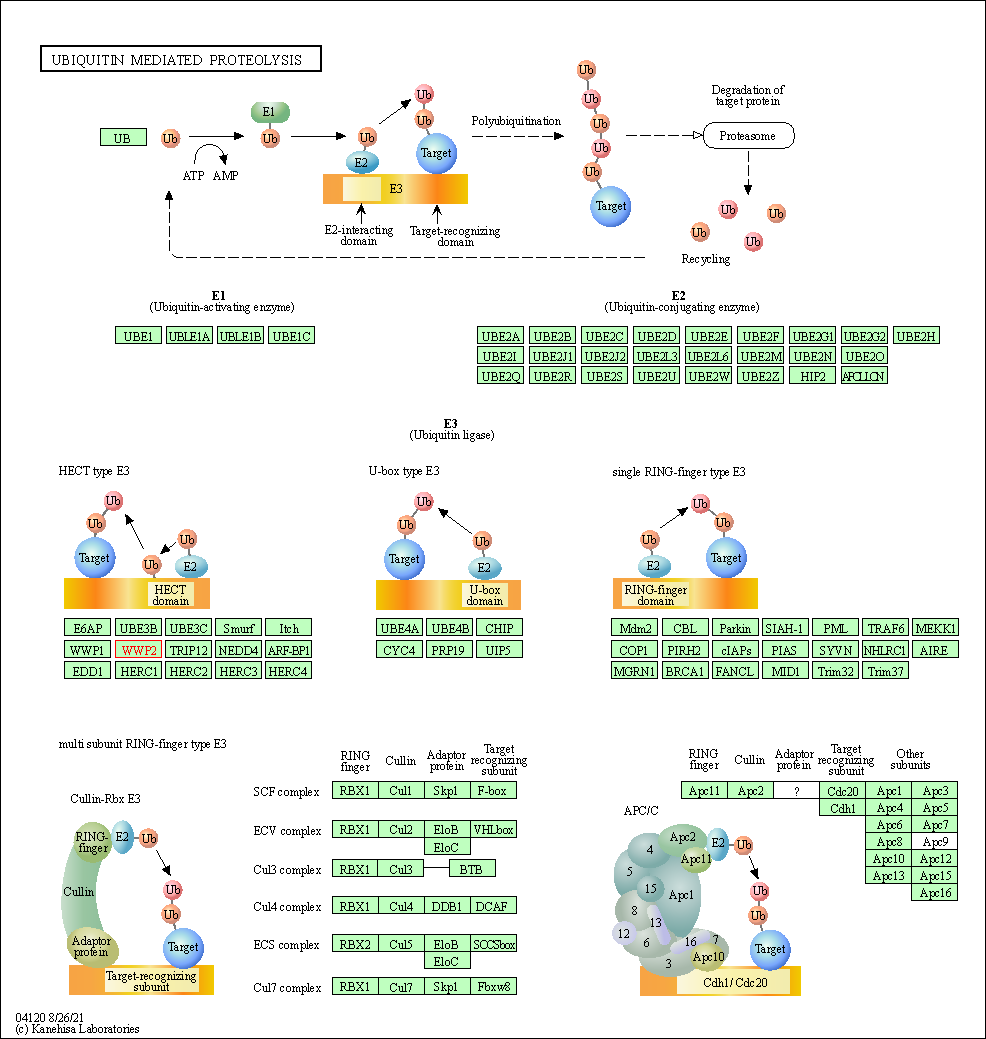Target Information
| Target General Information | Top | |||||
|---|---|---|---|---|---|---|
| Target ID |
T01054
(Former ID: TTDI00139)
|
|||||
| Target Name |
NEDD4-like E3 ubiquitin-protein ligase WWP2 (WWP2)
|
|||||
| Synonyms |
WW domaincontaining protein 2; WW domain-containing protein 2; NEDD4like E3 ubiquitinprotein ligaseWWP2; HECT-type E3 ubiquitin transferase WWP2; Atrophin1interacting protein 2; Atrophin-1-interacting protein 2; AIP2
Click to Show/Hide
|
|||||
| Gene Name |
WWP2
|
|||||
| Target Type |
Literature-reported target
|
[1] | ||||
| Function |
Polyubiquitinates POU5F1 by 'Lys-63'-linked conjugation and promotes it to proteasomal degradation; in embryonic stem cells (ESCs) the ubiquitination is proposed to regulate POU5F1 protein level. Ubiquitinates EGR2 and promotes it to proteasomal degradation; in T-cells the ubiquitination inhibits activation-induced cell death. Ubiquitinates SLC11A2; the ubiquitination is enhanced by presence of NDFIP1 and NDFIP2. Ubiquitinates RPB1 and promotes it to proteasomal degradation. E3 ubiquitin-protein ligase which accepts ubiquitin from an E2 ubiquitin-conjugating enzyme in the form of a thioester and then directly transfers the ubiquitin to targeted substrates.
Click to Show/Hide
|
|||||
| BioChemical Class |
Acyltransferase
|
|||||
| UniProt ID | ||||||
| EC Number |
EC 2.3.2.26
|
|||||
| Sequence |
MASASSSRAGVALPFEKSQLTLKVVSAKPKVHNRQPRINSYVEVAVDGLPSETKKTGKRI
GSSELLWNEIIILNVTAQSHLDLKVWSCHTLRNELLGTASVNLSNVLKNNGGKMENMQLT LNLQTENKGSVVSGGELTIFLDGPTVDLGNVPNGSALTDGSQLPSRDSSGTAVAPENRHQ PPSTNCFGGRSRTHRHSGASARTTPATGEQSPGARSRHRQPVKNSGHSGLANGTVNDEPT TATDPEEPSVVGVTSPPAAPLSVTPNPNTTSLPAPATPAEGEEPSTSGTQQLPAAAQAPD ALPAGWEQRELPNGRVYYVDHNTKTTTWERPLPPGWEKRTDPRGRFYYVDHNTRTTTWQR PTAEYVRNYEQWQSQRNQLQGAMQHFSQRFLYQSSSASTDHDPLGPLPPGWEKRQDNGRV YYVNHNTRTTQWEDPRTQGMIQEPALPPGWEMKYTSEGVRYFVDHNTRTTTFKDPRPGFE SGTKQGSPGAYDRSFRWKYHQFRFLCHSNALPSHVKISVSRQTLFEDSFQQIMNMKPYDL RRRLYIIMRGEEGLDYGGIAREWFFLLSHEVLNPMYCLFEYAGKNNYCLQINPASSINPD HLTYFRFIGRFIAMALYHGKFIDTGFTLPFYKRMLNKRPTLKDLESIDPEFYNSIVWIKE NNLEECGLELYFIQDMEILGKVTTHELKEGGESIRVTEENKEEYIMLLTDWRFTRGVEEQ TKAFLDGFNEVAPLEWLRYFDEKELELMLCGMQEIDMSDWQKSTIYRHYTKNSKQIQWFW QVVKEMDNEKRIRLLQFVTGTCRLPVGGFAELIGSNGPQKFCIDKVGKETWLPRSHTCFN RLDLPPYKSYEQLREKLLYAIEETEGFGQE Click to Show/Hide
|
|||||
| 3D Structure | Click to Show 3D Structure of This Target | AlphaFold | ||||
| Cell-based Target Expression Variations | Top | |||||
|---|---|---|---|---|---|---|
| Cell-based Target Expression Variations | ||||||
| Different Human System Profiles of Target | Top |
|---|---|
|
Human Similarity Proteins
of target is determined by comparing the sequence similarity of all human proteins with the target based on BLAST. The similarity proteins for a target are defined as the proteins with E-value < 0.005 and outside the protein families of the target.
A target that has fewer human similarity proteins outside its family is commonly regarded to possess a greater capacity to avoid undesired interactions and thus increase the possibility of finding successful drugs
(Brief Bioinform, 21: 649-662, 2020).
Human Tissue Distribution
of target is determined from a proteomics study that quantified more than 12,000 genes across 32 normal human tissues. Tissue Specificity (TS) score was used to define the enrichment of target across tissues.
The distribution of targets among different tissues or organs need to be taken into consideration when assessing the target druggability, as it is generally accepted that the wider the target distribution, the greater the concern over potential adverse effects
(Nat Rev Drug Discov, 20: 64-81, 2021).
Human Pathway Affiliation
of target is determined by the life-essential pathways provided on KEGG database. The target-affiliated pathways were defined based on the following two criteria (a) the pathways of the studied target should be life-essential for both healthy individuals and patients, and (b) the studied target should occupy an upstream position in the pathways and therefore had the ability to regulate biological function.
Targets involved in a fewer pathways have greater likelihood to be successfully developed, while those associated with more human pathways increase the chance of undesirable interferences with other human processes
(Pharmacol Rev, 58: 259-279, 2006).
Biological Network Descriptors
of target is determined based on a human protein-protein interactions (PPI) network consisting of 9,309 proteins and 52,713 PPIs, which were with a high confidence score of ≥ 0.95 collected from STRING database.
The network properties of targets based on protein-protein interactions (PPIs) have been widely adopted for the assessment of target’s druggability. Proteins with high node degree tend to have a high impact on network function through multiple interactions, while proteins with high betweenness centrality are regarded to be central for communication in interaction networks and regulate the flow of signaling information
(Front Pharmacol, 9, 1245, 2018;
Curr Opin Struct Biol. 44:134-142, 2017).
Human Similarity Proteins
Human Tissue Distribution
Human Pathway Affiliation
Biological Network Descriptors
|
|
|
Note:
If a protein has TS (tissue specficity) scores at least in one tissue >= 2.5, this protein is called tissue-enriched (including tissue-enriched-but-not-specific and tissue-specific). In the plots, the vertical lines are at thresholds 2.5 and 4.
|

| KEGG Pathway | Pathway ID | Affiliated Target | Pathway Map |
|---|---|---|---|
| Ubiquitin mediated proteolysis | hsa04120 | Affiliated Target |

|
| Class: Genetic Information Processing => Folding, sorting and degradation | Pathway Hierarchy | ||
| Degree | 3 | Degree centrality | 3.22E-04 | Betweenness centrality | 3.63E-06 |
|---|---|---|---|---|---|
| Closeness centrality | 2.26E-01 | Radiality | 1.40E+01 | Clustering coefficient | 6.67E-01 |
| Neighborhood connectivity | 1.44E+02 | Topological coefficient | 4.33E-01 | Eccentricity | 12 |
| Download | Click to Download the Full PPI Network of This Target | ||||
| Target Regulators | Top | |||||
|---|---|---|---|---|---|---|
| Target-interacting Proteins | ||||||
| References | Top | |||||
|---|---|---|---|---|---|---|
| REF 1 | Expression of WW domain-containing protein 2 is correlated with pathological grade and recurrence of glioma. J Cancer Res Ther. 2017 Oct-Dec;13(6):1032-1037. | |||||
If You Find Any Error in Data or Bug in Web Service, Please Kindly Report It to Dr. Zhou and Dr. Zhang.

